Garlic Problems
Cabbage Aphid
GARLIC
There are more and more problems with garlic becoming more and more common. Some of these are only transmitted by planting diseased cloves or moving contaminated soil. Here is a bit about some of the common problems to watch out for when buying and planting garlic this fall.
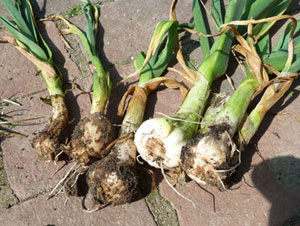 |
| Damage caused by the garlic bulb nematode |
GARLIC BULB NEMATODE (Ditylenchus dipsaci)
The stem and bulb nematode, also called the garlic bloat nematode, is a new garlic pest in the Northeast, first appearing in New York in 2010 and now being found throughout the Northeast. It has been spread by infested garlic seed. I am already getting reports of growers finding it in their plantings this year. The microscopic worms feed by piercing root and leaf cells with their stylet. Leaves of severely infected plants turn yellow and dry prematurely. Plants may be stunted. The roots may be missing and the basal plate may appear to have a dry rot similar toFusarium basal plate rot.
The pest is favored by wet, cool conditions. Although the pest is not active in hot dry weather, such weather may exacerbate symptoms. The nematode survives freezing and hot weather in soil and plant debris. It can only move short distances on its own. It is primarily moved by growers either moving soil (on tools, boots, etc.), in moving water, in debris from garlic or onion, or most commonly in garlic bulbs used for seed.
Cultural Control
The best way to avoid garlic bulb nematode is to use your own garlic for seed, IF it is not yet infested. Monitor for symptoms of infestation during the growing season and submit suspect plants to a diagnostic lab for confirmation. Contact me to get instructions on how to take and where to send the sample.
If it is determined that you do have the problem, DO NOT use your own garlic for seed. Even bulbs that show no symptoms may have low levels of infestation. Obviously, do not sell any garlic for seed from a potentially infested lot. Do not replant garlic in an infested field for at least four years. Other hosts include all Alliums, celery, parsley, and salsify. Mustards, sorghum-sudan grass, and other bio-fumigant cover crops planted during the rotation period have been shown to reduce nematode populations in a field. These nematodes can survive in dry debris so carefully clean equipment and storage areas.
There are no materials that offer control.
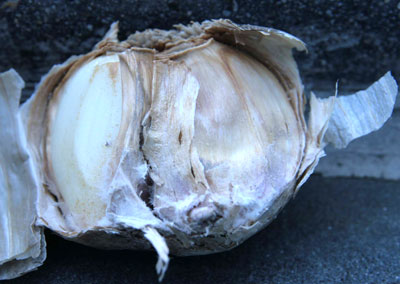 |
| Fusarium rot on garlic |
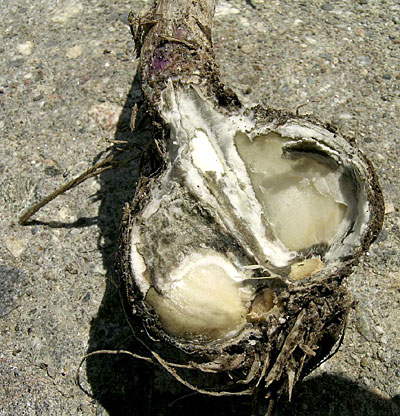 |
| White rot of garlic |
FUSARIUM ROT ON GARLIC (Fusarium oxysporum f. sp. cepae)
Fusarium rot superficially looks like bloat nematode damage. The pathogen invades the basal plate and the roots decay and die. If the infection took place late in the season, then you may not see symptoms until the garlic is in storage.
Fusarium is a fungus that persists in soils as resting spores. Warm, moist soil favors development of the disease. Under very moist conditions a pinkish-white mycelium may develop making the symptoms a bit like white rot. If you are unsure whether your problem is the bloat nematode, white rot, or fusarium rot then you should send a sample into the Pest Management Office for identification (https://umaine.edu/ipm/ipddl/).
If you have a fusarium problem, then a three year rotation to crops other than any Allium is recommended. Garlic should be stored in a cool (32-36 degrees F.), dry place in order to slow the development of the disease. (see the MOFGA fact sheet Storing Garden Vegetables ).
WHITE ROT OF GARLIC (Sclerotium cepivorum)
White rot is a very serious problem because it may spread fast, and once in a field it can persist for many years. Luckily it is a spotty disease and at this time is only present in a small number of fields around the northeast. Those farms can no longer grow any Allium crops in the infested fields.
White rot is one of the most destructive fungal diseases affecting the onion family. It is only a problem on crops in the onion family. [It is not the same pathogen as white mold, which attacks many other crops such as beans, carrots, lettuce, tomato, peppers and more]. Symptoms of white rot on the leaves include premature yellowing and dying of the older leaves and then death of the plant. That is not much different than many other garlic problems so is not a very useful diagnostic symptom, but the white, fluffy fungal growth (mycelia) on the root end of the bulb is the give away. Eventually this fungal growth moves around the bulb and inward between the storage leaves of onion and cloves of garlic. Small, black sclerotia (tiny hard, black bodies of dormant mycelia) form in the decaying tissue and throughout the white fluffy mycelia. Secondary infections by other fungi may occur.
The pathogen is not known to produce spores. This fungus reproduces only by the sclerotia, and it also spreads by direct contact, i.e., when the mycelium growing on one plant reaches the roots of the neighbor plant in the row. The sclerotia can lie dormant in the soil for many years until roots of a host plant grows nearby and the sclerotia are stimulated to germinate (see below). Dragging the pathogen around on boots, tillage or other equipment, or moving with soil in heavy rains are other ways the disease spreads. Also, animals feeding on diseased bulbs can defecate viable sclerotia.
The best control is good sanitation. Use clean seed cloves for garlic and clean onion sets and transplants. If only a small number of plants are infected, which is usually the case the first year it is found on a farm, pull the infected plants and destroy before sclerotia are formed.
An interesting idea for speeding up the eradication of white rot sclerotia from the soil is to stimulate them to germinate but not have a crop of Alliums for them. Sclerotia will sit waiting in the soil for 20 or more years until a signal is received that onions or garlic are growing nearby. The growing Allium releases a chemical that the sclerotia can sense. Over the past decade researchers have been studying methods that stimulate the sclerotia to germinate but, of course, with no Allium crop growing for the pathogen to complete its life cycle. This “biostimulation” reduces the number of sclerotia in the soil. There is not a specific recommendation yet, but a few things that may reduce sclerotia in the soil include:
• growing scallions which stimulate the sclerotia to germinate, but the scallions are harvested before the disease completes its life cycle
• making compost out of onion or garlic waste and spreading that in the spring or fall repeated for a bunch of years before trying to grow an Allium again
• making a sprayable concoction from ground up onion or garlic waste, or using garlic powder as a soil amendment for a few years before trying to go back to an Allium
For a report of a study done by Amy LeBlanc of biostimulation for this problem, see the reports of her SARE supported study at https://projects.sare.org/sare_project/fne13-782/
If the disease is known to be present, or if onions from other farms are being stored and packed, equipment, storage bins, etc. should be thoroughly pressure-washed and then disinfested for ten minutes with a 0.5% solution of sodium or calcium hypochlorite, (for example, 1:10 dilution of a household bleach). Then rinse with potable water.
Seed producers should execute extra diligence and may want to regularly disinfect any surface in contact with garlic.
Since chlorine materials will be inactivated by organic matter stuck on boots, quaternary ammonium compounds may be used as boot dips inside storage areas and packing sheds, and before and after leaving fields. Quaternary should not be used on any apparatus that is in direct contact with the garlic or onions or any other crop. Disposal of the dip solution must be in a manner that does not contaminate the soil, water or crop. Note: not all quaternary ammonium products are labeled for boot washes so read the label.
At this time, no material has shown efficacy.
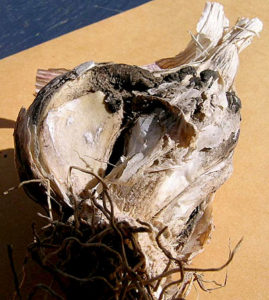 |
| Botrytis porri on garlic. Sideman photo. |
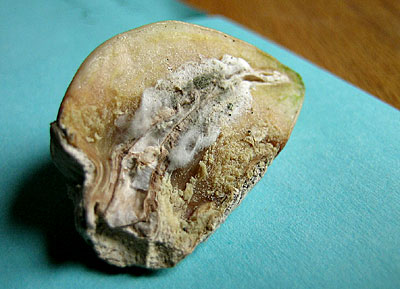 |
| Penicillium decay on garlic. Sideman photo. |
BOTRYTIS ROT
Botrytis rot of garlic is caused by the species, Botrytis porri, which is a different species of the very common genus that includes the speices Botrytis cinerea that causes gray mold. It is not common but sometimes does incite severe disease and may cause major crop loss.
In the field, garlic plants infected with Botrytis rot are stunted and have dead or dying outer leaves. Since most garlic diseases have similar symptoms, it is important to send a sample to the University of Maine Pest Management Office for a positive ID. Infection develops at soil level and initially looks water soaked but later becomes dry and brown. If conditions are not favorable for the fungus, plants infected with Botrytis porri sometimes recover. If conditions are favorable for fungal growth, and in plants infected later in the season, distinctively large (up to 2 cm) black sclerotia form around the rotting neck of the garlic. At this point the disease is clearly identifiable. Sclerotia are hardened bits of fungal mycelia that are very resistant to environmental stresses of wet, cold, dry and hot. In other words, sclerotia are tough and can survive almost anything in nature. The sclerotia overwinter, and in spring they produce spores that start the cycle again. Under cool, wet conditions, the disease can become epidemic in a field. It does not progress when the weather is warm and dry; in such conditions, proper irrigation is important in preventing the disease from spreading, so don’t keep fields excessively wet. Good air flow is important, so avoid weedy fields and don’t crowd plants. Excessive nitrogen may also be implicated in susceptibility. Clean seed and crop rotation also help prevent Botrytis rot.
PENICILLIUM DECAY
Penicillium decay may be responsible for poor plant stands in the field but is better known for causing garlic to decay in storage. It is one of the most common storage problems and arises when the harvested garlic does not dry quickly and well. The common name, blue mold, describes the most obvious symptom: The fungus frequently produces a mass of blue spores on the surface of decaying cloves. Spores are not always produced; sometimes, especially early in its growth and under drier conditions, you will see only white mycelia (a mass of fungal filaments) growing on the surface of cloves. Frequently, pencillium rot affects only a few cloves in a head. I have gotten suspicious heads of garlic to sporulate by placing them in a plastic bag for a few days; when the blue spores form, I know the disease is present. Symptoms in the field include wilted or stunted seedlings due to decay. The fungus can spread into the stem plate of young plants, affect the development of roots and result in weak, yellow leaves.
The pathogen is usually Penicillium hirsutum. Inoculum survives from year to year in infected cloves. It does not survive well in soil, so clean seed and crop rotation together very effectively minimize the problem. Even within a single head, some cloves may be infected while others are clean – but when you break heads apart to plant the seed, Penicillium spores are inevitably spread to other cloves, and infection occurs through small wounds. To minimize spreading the problem when you see a few infected cloves, handle the seed carefully to minimize wounding, and plant the seed as soon as possible after separating the cloves from the bulb.
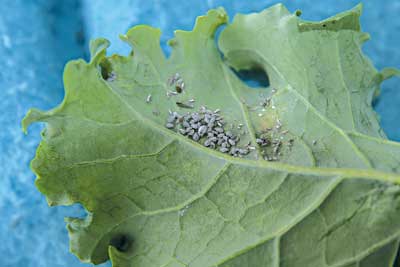 |
| Cabbage aphids on kale growing in a tunnel. Photo by Eric Sideman |
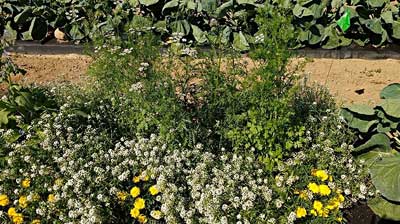 |
| Habitat plants flowering among brussels sprouts. Photo by Becky Sideman |
CABBAGE APHID (This article is reprinted from The MOF&G, Spring 2017)
Although it may seem so, the cabbage aphid is not a new pest. My favorite discussion of this pest is in a 1928 text called “Destructive and Useful Insects, Their Habits and Control,” by C.L. Metcalf and W.P. Flint. Even though it was considered a destructive pest back then, to me it seems like the destruction has vastly increased in the past few decades. If you have not seen this pest yet, get ready. The severe damage is on fall crops, but successful management depends on continued vigilance all season, starting in spring. The crops attacked include cabbage, Brussels sprouts, kale, cauliflower, as well as wild mustard and shepherd’s purse.
Aphids are small, soft bodied insects that feed by stabbing their hollow, sharply pointed mouthparts through the epidermis of the plant and then sucking the juices out of the cells. Aphids are so tiny that you do not notice them unless you are searching for them. What catches the grower’s eye is a wrinkled, sick looking plant. If you see that, then search in all the crevices and undersides of the leaves. Cabbage aphids tend to cluster even more than do other species of aphids, often making piles of themselves.
Badly infested plants may turn yellow and even wilt. To make matters worse, aphids excrete their waste as a material kindly referred to as “honeydew” – a dark, gummy liquid that not only serves as a good medium for mold growth but in itself is unsightly. That honeydew and the aphids hiding in crevices and even under the wrappings of brussels sprouts greatly reduce the appeal and marketability of crops.
As with most pests, understanding the biology and where and how the pest lives and reproduces are the keys to management. The first step is finding where and when you can reduce the population with some cultural practice, and when in the life history the pest is most susceptible to a pesticide in case you need to turn to that last resort.
Life History
The life history of aphids is particularly complicated. Typically aphids pass the winter as fertilized eggs on leaves of perennial plants or crop debris. Eggs hatch in early spring. These first nymphs that hatch out of the overwintered eggs are called “stem mothers” because each of them may end up starting a great colony of aphids. All of these stem mothers are female and have a remarkable ability to reproduce without mating. Their vast numbers of offspring are born live – that is, already hatched from the egg (ovoviviparously). These new aphids also can produce young without mating, and also ovoviviparously. Reproduction can commence when the aphids are only a week or so old. A vast number of aphids may arise quickly, and they all cluster around the original stem mother so that patches of the plant may be covered.
At some point, possibly because the food becomes unsatisfactory or for some other reason, some of these females develop wings. These winged aphids fly to new plants and start a new colony in the same fashion as above: without mating and with young being born ovoviviparously.
As the days shorten in fall, a new kind of generation of winged aphids arises, made up of both males and females. These are called fall migrants. They may fly off and find new plants, and their offspring can mate. These females lay eggs that can overwinter.
Interestingly, farther south cabbage aphids can overwinter as active adults and can continue to reproduce ovoviviparously. I believe this is happening in the north now in tunnels where kale and its relatives are grown all winter.
Managing the Pest
Natural management of the size of the population of cabbage aphids is prevalent. This may be hard to believe when you encounter masses of aphids on your crops, but many natural enemies will eat those aphids. The most common are braconid wasps, which lay their eggs in the aphid, and then the larval wasp consumes the aphid from the inside out. Lady beetles are common parasites munching away as they patrol the fields. Syrphid flies lay eggs near aphid colonies, and their larvae crawl along and consume aphids in large numbers. There is lots of help out there, but aphids also have amazing reproductive potential, and which way the battle goes is always a tossup. Anything you can do to favor the predators and parasitoids should be good.
Research at UNH
Talia Levy, an undergraduate student at the University of New Hampshire, works as a summer field technician for Dr. Becky Sideman, the UNH vegetable specialist. While collecting data in some of Sideman’s Brussels sprouts variety trials (see “Brussels Sprouts Variety Trial and Topping Study, 2013 & 2014” at https://extension.unh.edu/resources/files/Resource003914_Rep5563.pdf), Levy noted the mass of cabbage aphids on some plants. She was taking an integrated pest management course with Dr. Alan Eaton at the time, so her mental wheels started to turn. With the help of Eaton and Sideman, she designed an experiment to test some management techniques, especially using plants that attracted and supported predators and parasitoids.
Levy set up replicated plots, including plots where nothing was done to control the cabbage aphid, plots with attractive flowers (habitat plants where predators and parasitoids could land and feed on pollen when no aphids where present), and plots treated with some organically approved insecticides.
In her results, the plots with habitat plants did not have significantly different aphid populations than control plots, although the data did show that the flowers attracted more insect enemies of aphids, notably parasitic wasps and syrphid flies, that were destroying lots of aphids, so more research may be needed regarding this aspect of the experiment. Alyssum, cilantro and phacelia attracted the largest number of beneficials, and alyssum attracted the most syrphid flies.
Levy’s work did show that organic pesticides can work very well. Aphids were controlled well by rotating two insecticides, Azera and M-pede. Azera contains two active ingredients: azadirachtin (extracted from neem seeds) and pyrethrins; M-pede is an insecticidal soap. Levy monitored the aphid level by scouting once a week and sprayed only when threshold levels were reached, based on the University of California report at https://ipm.ucanr.edu/PMG/r108300811.html.
You can see her report in full at
https://extension.unh.edu/resources/files/Resource006332_Rep9072.pdf
Cultural Management
Of course cultural practices should be the first line of defense. Since the cabbage aphid overwinters as an egg on the crop, crop rotation is very important. Do not plant a host crop in the same field where one grew the year before. Furthermore, burying the crop debris will bury the overwintering eggs. If you have a winter tunnel with host crops, be sure to destroy those before the aphids can spread to your spring planted field crops. Manage host weeds, especially perennial or winter annual weeds that may harbor overwintering eggs. During the growing season, destroy host crops when harvest is done so that they do not become a harbor for the pest. Most important, keep your eyes open all season, watch small clusters of cabbage aphids, and be ready if a population explosion occurs in late summer.
